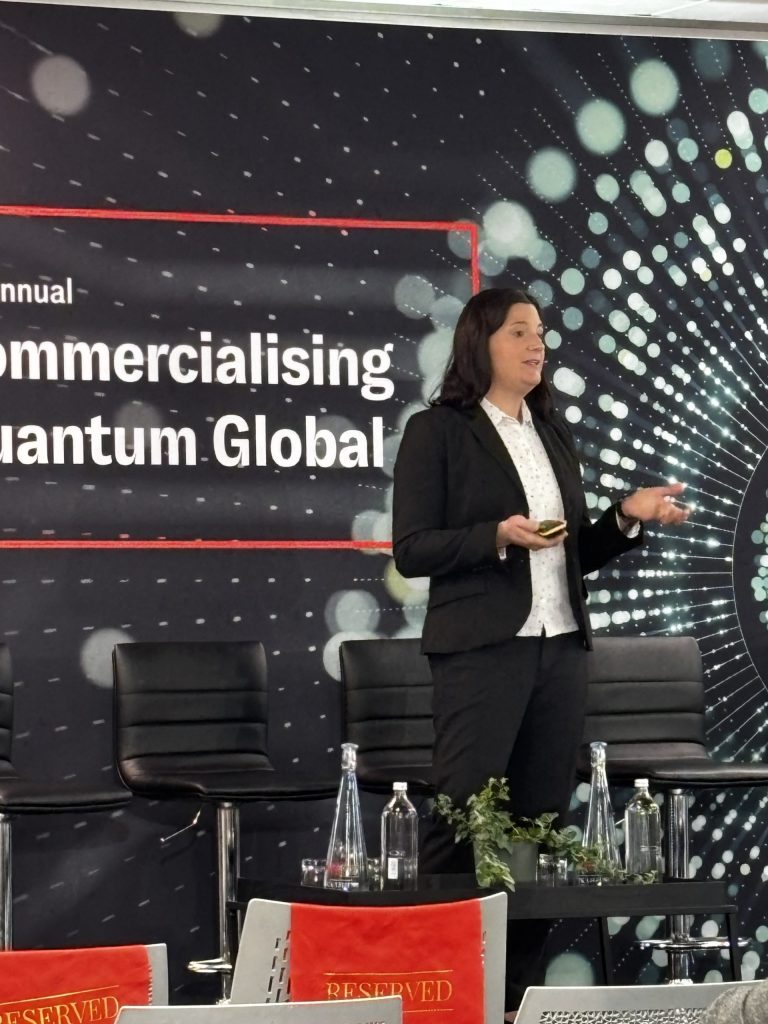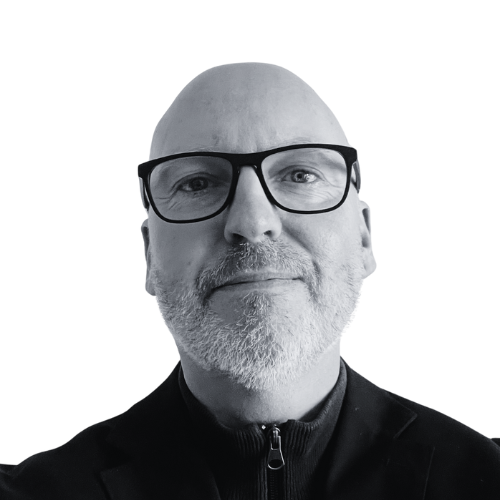Artificial Intelligence
Net zero
Quantum
Wise words and waggishness… December 2025
Reading time: 5 mins
Speakers at 4th Economist Impact Commercialising Quantum Global event focus on reality. Here we highlight some key moments
Quantum computing is having a moment – but not quite the one the industry hoped for, at least not yet. It’s 2025, and the sector is now awash with start-ups and flush with venture capital, but still waiting for its first killer application. More than 80 hardware vendors are jostling for relevance. Governments are throwing weight behind national strategies. And investors are starting to ask tougher questions.
It’s fair to say that quantum computing is at a crossroads. The industry is no longer in its infancy, but it hasn’t yet proved its maturity. There is a growing divide between promise and performance, hype and honesty, research and revenue. What happens next will determine whether quantum follows the trajectory of transformational platforms like AI and the internet, or falters under the weight of its own complexity and ambition.
At the recent Economist Impact Commercialising Quantum Global event in London, speakers pulled back the curtain on the sector’s ambitions and anxieties. From Robert Sutor’s sweeping market analysis to the XPRIZE Foundation’s hunt for practical algorithms, plus the UK government’s concerted push to build a national quantum infrastructure, the discussions laid bare both the scale of the opportunity and the gaps that still need to be bridged.
Robert Sutor, former IBM exec and now CEO of Sutor Group Intelligence and Advisory, offered a no-nonsense assessment of where the industry stands.
“It’s very easy to say, ‘this company got funding’ or ‘this modality looks promising’. But that’s just one tile in a vast, complex picture,” he said. Sutor likened the quantum landscape to a jigsaw puzzle where everyone is fixated on single pieces, while few are assembling the full image.
There are 84 companies worldwide attempting to build quantum processing units (QPUs), he noted. Most are unprofitable. Many are overhyped. And historically, between 75% and 90% of start-ups fail. The quantum sector is unlikely to beat those odds.
“If I fast-forward five years, I’d probably say this field will be about a quarter of the size it is today,” Sutor said.
But Sutor’s bigger point was about what the market is missing. While attention is often on flashy hardware breakthroughs, real commercial viability depends on something less visible – the software stack and supply chain behind it.
“In all tech cycles, software eventually dominates,” Sutor said. “But with quantum, it comes late.”
This is starting to change. A recent major funding round for Israeli start-up Classiq ($110 million in what is reportedly the largest-ever quantum software funding round) highlighted how interest is beginning to shift towards software infrastructure, especially tools that bridge hardware diversity and enable cross-platform development.
Sutor detailed the layers needed to make quantum computers actually useful, including algorithm design, compilers, control systems, error mitigation, and hybrid quantum-classical orchestration.
For now though, the real action is in stitching components together.
“You don’t want to imagine a quantum computer as a big, monolithic device. We need to connect smaller quantum systems to build up scale,” he said. That means that components matter: cryo systems, lasers, cabling, chips, and more. For countries without the resources to build full-stack QPUs, becoming a component or software supplier could be a strategic play.
Of course, one of the biggest software vendors of them all, Microsoft, is already working hard on its quantum strategy and research. Microsoft corporate VP Zulfi Alam, who in previous roles has worked across Xbox and HoloLens, now looks after its quantum computer development. He echoed the need for real-world relevance, arguing that materials and chemistry, in particular, are emerging as key quantum applications.
“It is very hard to compute all the electronic interactions between various electrons,” he said. “Just being able to simulate that the right way is super hard.”
Microsoft, he added, recently discovered a new solid-state battery electrolyte – “a molecule that didn’t exist” – using quantum tools, demonstrating how such tools can unlock previously unimaginable outcomes.
This idea of systems thinking is central to the UK’s quantum strategy. Speaking at the event, Sir Peter Knight, chair of the UK National Quantum Technologies Programme Strategic Advisory Board, described a deliberate, multi-decade plan to build an “escalator” from research to commercial product.
“We funded research hubs, doctoral training centres, skills programmes, and industry-led challenge projects,” said Knight. “We set up the National Quantum Computing Centre. We put early capital in through the British Business Bank and SBRI. We’re using procurement as a tool for adoption.”
The UK’s National Quantum Computing Centre (NQCC) now hosts a testbed programme, allowing companies, researchers, and government departments to evaluate and benchmark a range of QPU platforms. The goal is to prevent premature bets on individual technologies and to provide data that informs future procurement.
“We’re building the infrastructure to scale,” added Knight. “It’s about climbing the mountain slowly and carefully, with open eyes and the right partners.”
Knight pointed to one of the UK’s most ambitious goals, enabling UK-based quantum computers to run a trillion operations by 2035.
“We call it the quantum mountain,” he said, referencing a chart mapping the number of qubits, error rate, and number of operations before decoherence. “We’re not at the peak, we’re still in the foothills… the journey toward fault-tolerance is now much closer than it was,” he added, noting significant progress in error correction.
But the climb remains steep, and hype can be damaging. Knight warned against both techno-optimism and cynicism.
“Let’s not be Lord Kelvin,” he said, referencing the 19th-century physicist who wrongly predicted that heavier-than-air flight was impossible. “Hype is dangerous, but so is denial.”
Richard Murray, co-founder and CEO of ORCA Computing, cut to the chase with one pointed comment in a panel discussing quantum advantage and benchmarking. While most of the panel argued over qubits, Murray responded, “ROI, that’s what we should be talking about.”
Meanwhile, IBM’s Jerry Chow made a strong case that scalable utility is already within reach. “We demonstrated quantum utility in 2023, where quantum execution becomes the benchmark against which approximate classical solvers are judged,” he said, pointing to IBM’s work on Ising spin models that classical methods struggled to match. But Chow acknowledged that even with industry-leading hardware, the journey to quantum advantage remains ongoing.
However, Chow did reveal that that IBM’s next-generation processor, slated for launch later this year, will feature a square lattice architecture and 120 qubits, part of what IBM calls its “Nighthawk” generation.
“We boldly believe that we’ll get there by 2026,” he added.

While governments build roadmaps and vendors race to climb the performance curve, the commercial business case for quantum remains uncertain.
That’s where the XPRIZE Quantum Applications competition offers a useful reality check.
Kathrin Spendier, technical prize director at the XPRIZE Foundation, explained how the competition aims to accelerate quantum for real-world, societal impact, not just technical benchmarks. More than 220 teams from 39 countries are competing, with categories ranging from novel algorithm design to optimisation of known use cases.
And tellingly, the competition is still accepting wildcard entries.
Across every session, one message was continually echoed and that was that no one wins alone in quantum.
Tom Newby, head of the Office for Quantum at DSIT, explained how the UK’s national strategy puts international collaboration front and centre. The UK has signed agreements with the US, Japan, Canada, Australia, and several European countries. It is also rejoining the Horizon Europe programme for quantum research.
When asked by panel host Laveena Iyer, global tech and telecoms analyst for Economist Intelligence Unit if he had any good examples of companies he has worked with in the UK, in terms of advising them and how they’ve approached this local versus global market question, Newby said he didn’t it’s for government to advise on when companies take that judgment, “but what we do do is support our companies to internationalise when they feel ready.”
David Camerlengo, senior trade and investment commissioner for Australia, reinforced the point. “Many of our quantum companies are born global. They have to be. The customers, the talent, the money, they’re not all in one place.”
Joe Niemela, from UNESCO and the International Centre for Theoretical Physics, warned of a growing “quantum divide”, echoing the digital divide of the 1990s. Without international cooperation, he argued, quantum risks becoming an elite tool accessible only to the richest nations.
The UK, for its part, is trying to offer a model for how to proceed – slow, deliberate, inclusive, and well-funded. Its success will depend not just on big targets, but on how many companies it helps survive the journey.
“We have breadth. We have depth,” said Knight. “But we need community building and partnership with our friends around the world to make this real.”

Working as a technology journalist and writer since 1989, Marc has written for a wide range of titles on technology, business, education, politics and sustainability, with work appearing in The Guardian, The Register, New Statesman, Computer Weekly and many more.
Quantum
Reading time: 10 mins
Quantum
Reading time: 10 mins
Quantum
Reading time: 11 mins
Robotics
Reading time: 1 mins
Quantum
Reading time: 3 mins